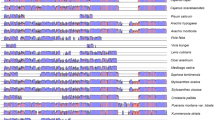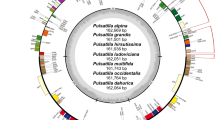Abstract
A phylogenetic analysis ofPanax was performed using restriction site variations of eight PCR-amplified chloroplast regions. Twenty populations were examined, representing 13 of the 14 species ofPanax. Aralia cordata was used as the outgroup. The 11 restriction endonucleases produced a total of 105 restriction sites and length variations from the large single-copy region of cpDNA. Forty restriction variations are polymorphic. The cpDNA tree is largely congruent with the nuclear ribosomal ITS phylogeny. Similar to the ITS tree, the cpDNA dataset suggests the following relationships: (1)P. trifolius from eastern North America is sister to the clade consisting of all otherPanax species; (2)P. ginseng andP. japonicus from eastern Asia form a clade withP. quinquefolius from eastern North America; (3) the HimalayanP. pseudoginseng is most closely related toP. stipuleanatus of southwestern China; and (4) the medicinally importantP. notoginseng forms a clade with the closely relatedP. bipinnatifidus, P. ginseng, P. japonicus, P. major, P. quinquefolius, P. sinensis, P. wangianus, andP. zingiberensis. Two biogeographic disjunctions are detectable withinPanax. One is the connection of the eastern North AmericanP. trifolius with the rest ofPanax species. The other is the more recent disjunction between the North AmericanP. quinquefolius and the eastern AsianP. ginseng andP. japonicus. The active orogenies caused by the collision of the Indian Plate with Asia may have facilitated the diversification ofPanax taxa in Asia in the late Tertiary.
Similar content being viewed by others
References
Axelrod D. I., Al-Shehbaz I., Raven R. H. (1998) History of the modern flora of China. In: Zhang A.-L., Wu S.-G. (eds.) Floristic characteristics and diversity of East Asian plants. China Higher Education Press, Beijing, pp. 43–55.
Bremer K. (1988) The limits of amino acid sequence data in angiosperm phylogenetic reconstruction. Evolution 42: 795–803.
Carlson A. W. (1986) Ginseng: America's botanical drug connection to the Orient. Econ. Bot. 40: 233–249.
Demesure B., Comps B., Petit R. J. (1995) A set of universal primers for amplification of polymorphic non-coding regions of mitochondrial and chloroplast DNA in plants. Mol. Ecol. 4: 129–131.
Duc N. M., Nham N. T., Kasai R., Ito A., Yamasaki K., Tanaka O. (1993) Saponins from Vietnamese ginseng,Panax vietnamensis Ha et Grushv. Collected in central Vietnam. I. Chem. Pharm. Bull. 41: 2010–2014.
Duc N. M., Kasai R., Ohtani K., Ito A., Nham N. T., Yamasaki K., Tanaka O. (1994) Saponins from Vietnamese ginseng,Panax vietnamensis Ha et Grushv. Collected in central Vietnam. II. Chem. Pharm. Bull. 42: 115–122.
Dumolin-Lapegue S., Demesure B., Fiensi S., Corre V. L., Petit R. J. (1997) Phylogeographic structure of white oaks through the European continent. Genetics 146: 1475–1487.
Felsenstein J. (1981) Evolutionary trees from DNA sequences: a maximum likelihood approach. J. Mol. Evol. 17: 368–376.
Felsenstein J. (1985) Confidence limits on phylogenies: an approach using the bootstrap. Evolution 39: 783–791.
Graham A. (ed.) (1972) Floristics and paleofloristics of Asia and eastern North America. Elsevier, Amsterdam.
Hara H. (1970) On the Asiatic species of the genusPanax. J. Jap. Bot. 45: 197–212, plates 10–12.
Hoo G., Tseng C.-J. (1973) On the Chinese species ofPanax Linn. Acta Phytotax. Sin. 11: 431–438.
Hoo G., Tseng C.-J. (1978) Angiospermae, Dicotyledoneae, Araliaceae, Flora Reipublicae Popularis Sinicae, vol. 54. Science Press, Beijing. (in Chinese)
Hopkins D. M. (1967) The Bering land bridge. Stanford University Press, Stanford.
Hu S. Y. (1976) The genusPanax (ginseng) in Chinese medicine. Econ. Bot. 30: 11–28.
Kimura M. (1980) A simple method for estimating evolutionary rates of base substitution through comparative studies of nucleotide sequences. J. Mol. Evol. 16: 111–120.
Li H. L. (1942) The Araliaceae of China. Sargentia 2: 1–134.
Li H. L. (1952) Floristic relationships between eastern Asia and eastern North America. Trans. Amer. Philos. Soc. 42: 371–429.
Li H. L. (1972) Eastern Asia-Eastern North America species-pairs in wide-ranging genera. In: Graham A. (ed.) Floristics and paleofloristics of Asia and eastern North America. Elsevier, Amsterdam, pp. 65–78.
Mes T. H. M., Friesen N., Fritsch R. M., Klass M., Konrad B. (1997) Criteria for sampling inAllium based on chloroplast DNA PCR-RFLP's. Syst. Bot. 22: 701–712.
Messinger W., Hummer K., Liston A. (1999)Ribes (Grossulariaceae) phylogeny as indicated by restriction-site polymorphisms of PCR-amplified chloroplast DNA. Plant Syst. Evol. 217: 185–195.
Plunkett G. M., Soltis D. E., Soltis P. S. (1997) Clarification of the relationship between Apiaceae and Araliaceae based onmatK andrbcL sequence data. Amer. J. Bot. 84: 565–580.
Potokina E., Tomooka N., Vaughan D. A., Alexandrova T., Xu R.-Q. (1999) Phylogeny ofVicia subgenusVicia (Fabaceae) based on analysis of RAPDs and RFLP of PCR-amplified chloroplast genes. Genet. Resources Crop Evol. 46: 149–161.
Saitou N., Nei N. (1987) The neighbor-joining method: a new method for reconstructing phylogenetic trees. Mol. Biol. Evol. 4: 406–425.
Schlessman M. A. (1990) Phenotypic gender in sex changing dwarf ginseng,Panax trifolium (Araliaceae). Amer. J. Bot. 77: 1125–1131.
Schlessman M. A. (1991) Size, gender, and sex change in dwarf ginseng,Panax trifolium (Araliaceae). Oecologia 87: 588–595.
Seemann B. (1868) On the genusPanax. J. Bot. (Morat) 6: 52–58.
Swofford D. L. (1999) PAUP*: phylogenetic analysis using parsimony, version 4.02b. Sinauer Assoc., Sunderland, MA.
Swofford D. L., Olsen G. L., Waddell P. J., Hillis D. M. (1996) Phylogenetic inference. In: Hillis D. M., Moritz C., Mable B. K. (eds.) Molecular systematics, 2nd edn. Sinauer Assoc., Sunderland, MA, pp. 407–514.
Tanaka O. (1990) Recent studies on glycosides from plant drugs of Himalaya and south-western China: chemogeographical correlation ofPanax species. Pure Appl. Chem. 62: 1281–1284.
Tanaka O., Kasai R. (1984) Saponins of ginseng and related plants. In: Herz W., Grisebach H., Kirby G. W., Tamm C. (eds.) Progress in chemistry of organic natural products, vol. 46. Springer, New York, pp. 1–76.
Wallich N. (1829) An account of the Nipal ginseng. Trans. Med. Phys. Soc. Calcutta 4: 115–120.
Wen J. (1993) Generic delimitation ofAralia (Araliaceae). Brittonia 45: 47–55.
Wen J. (1999) Evolution of eastern Asian and eastern North American disjunct pattern in flowering plants. Ann. Rev. Ecol. Syst. 30: 421–455.
Wen J., Zimmer E. A. (1996) Phylogeny and biogeography ofPanax L. (the ginseng genus, Araliaceae): inferences from ITS sequences of nuclear ribosomal RNA. Mol. Phylogenet. Evol. 6: 167–177.
Wen J., Shi S., Jansen R. K., Zimmer E. A. (1998) Phylogeny and biogeography ofAralia sect.Aralia (Araliaceae). Amer. J. Bot. 85: 866–875.
Wen J., Nowicke J. W. (1999) Pollen ultrastructure ofPanax (the ginseng genus, Araliaceae), an eastern Asian and eastern North America disjunct genus. Amer. J. Bot. 86: 1624–1636.
Wen J., Shi S. (1999) A phylogenetic and biogeographic study ofHamamelis (Hamamelidaceae), an eastern Asian and eastern North American disjunct genus. Biochem. Syst. Ecol. 27: 55–66.
Wen J., Plunkett G. K., Mitchell A., Wagstaff S. (2001) Evolution of Araliaceae: a phylogenetic analysis based on the ITS sequences of nrDNA. Syst. Bot. (in press).
Wolfe A. D., Elisens W. J., Waston L. E., dePamphilis C. E. (1997) Using restriction-site variation of PCR-amplified cpDNA genes for phylogenetic analysis of tribe Cheloneae (Scrophulariaceae). Amer. J. Bot. 84: 555–564.
Wu Z. Y. (1983) On the significance of Pacific intercontinental discontinuity. Ann. Missouri Bot. Gard. 70: 577–590.
Yang D.-Q. (1981) The cyto-taxonomic studies on some species ofPanax L. Acta Phytotax. Sin. 19: 298–303. (in Chinese with English summary).
Zhou J., Huang W.-G., Wu M.-Z., Yang C.-R., Feng K.-M., Wu Z.-Y. (1975) Triterpenoids fromPanax Linn. and their relationship with taxonomy and geographical distribution. Acta Phytotax. Sin. 13(2): 29–45, plates 6–7. (in Chinese with English summary).
Author information
Authors and Affiliations
Rights and permissions
About this article
Cite this article
Choi, HK., Wen, J. A phylogenetic analysis ofPanax (Araliaceae): Integrating cpDNA restriction site and nuclear rDNA ITS sequence data. Pl Syst Evol 224, 109–120 (2000). https://doi.org/10.1007/BF00985269
Received:
Accepted:
Issue Date:
DOI: https://doi.org/10.1007/BF00985269




